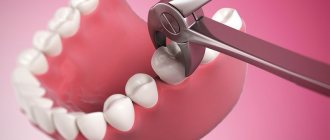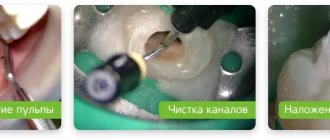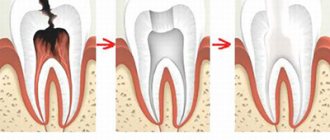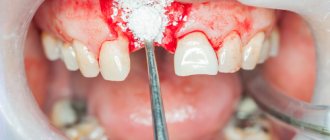Tooth depulpation is an endodontic manipulation to remove the neurovascular bundle from the tooth cavity and/or tooth roots. When is tooth removal necessary?
Depulpation of diseased teeth is carried out when the dental pulp is inflamed, due to the penetration of caries through the walls of the tooth to the intrapulp chamber. Through the carious gap created in the enamel and dentin, microbes and toxins enter the pulp, and the death of nerve fibers and capillaries of the pulp begins. Severe pain occurs when the tooth comes into contact with temperature and chemical irritants, i.e. for cold, hot, sour, sweet, etc.
Depulpation of teeth for prosthetic purposes
For grinding for a crown or dental bridge, the teeth are first depulped. High-quality depulpation (depulpation) of intact teeth allows you to avoid inflammatory processes (cysts and granulomas) under the root of the tooth on which the crown is installed. A non-pulp tooth under a crown can cause severe pain due to inflammation of the pulp.
How does pulp removal occur?
The process of depulpation allows you to stop the penetration of infection from the crown and root parts of the tooth under the apex, behind the root of the tooth, into the bone tissue surrounding the tooth. Thus, timely tooth depulpation prevents complications such as periodontitis , cysts or dental granuloma from developing. There are complete removal of the tooth pulp (from the roots and from the coronal part of the tooth) - pulp extirpation, and incomplete removal of the pulp (only from the coronal part of the tooth) - pulp amputation. Pulp amputation is carried out in the initial stage of pulpitis in order to preserve viable pulp in the root canals of the tooth.
What is depulpation and what is its essence?
What does tooth depulpation mean? Let's break the word down into parts - “de” means “removal”, and “pulp” refers to the soft neurovascular bundle that is located inside the tooth cavity and in the root canals. That is, depulpation or depulpation is the removal of the so-called “dental nerve”. After which the “empty” areas are filled with filling mass or pins, and then closed with crowns, inlays or special fasteners for dentures. Depulpation[1] is irreversible, i.e. a new pulp does not form in place of the removed one. Dental tissues cease to receive nutrition from the inside, and the tooth itself is considered “dead.” But this does not mean at all that it will fall out soon.
Any dentist should be able to carry out this procedure, but in the field of work this is most often done by dental therapists or more specialized specialists - endodontists. That is, if a patient comes to an orthopedist for a prosthesis, then if pulp removal is necessary, he will refer the person to a dentist-therapist.
What is the procedure
Depulpation is a dental procedure in which the pulp, the neurovascular bundle of the tooth, is removed. The pulp ensures the vitality of the tooth and, in particular, its sensitivity due to the large number of nerve endings. Depulpation is a complex dental procedure that can cause severe pain. After depulpation, the tooth actually dies, since metabolic and restoration processes no longer take place in it, but retains its chewing function.
What is the purpose of depulpation?
The goal of the procedure is to achieve several important results that will allow the patient to wear the prosthesis for a long time. Moreover, during the entire period of wearing the person will not be bothered by pain and the need to remove, for example, a crown. Let's take a closer look at what effect should be achieved:
- the pulp will not overheat during grinding of the stump and, accordingly, will not become inflamed (i.e., pulpitis will not appear under the crown),
- cariogenic bacteria will not penetrate into the pulp (i.e., pulpitis is again excluded),
- It will be possible to place pins or a core inlay into the canals: this will strengthen the restoration, i.e. it will last longer.
Don't know what type of prosthetics to choose?
We will help in the selection, advise where to read more information and compare types of prosthetics.
Consultation with an orthopedic doctor in Moscow clinics is free! Call now or request a call
Working hours: from 9:00 to 21:00 - seven days a week
Tooth nerve removal
Removing the nerve of a tooth is the extraction of loose connective tissue from the pulp of the canals. This procedure is prescribed if the nerve of the tooth is inflamed as a result of pulpitis or another disease. In most cases, it is performed under anesthesia, with the removal of the living pulp. The procedure is also called depulpation, depulpation, devitalization.
Who is indicated for tooth nerve removal?
Inflammation of the dental nerve is provoked by an advanced form of caries. If it is not treated in time, harmful mycobacteria will destroy dental tissue and eventually reach the pulp chamber - the area where the nerve is located. The inflammatory process is called “pulpitis”. If you have a severe toothache, consult a dentist immediately. This is the only way to preserve the tooth and prevent its removal. During the operation, the pulp is removed in whole or in part: such dental manipulation provides relief from the inflammatory and infectious process and allows it to be prevented from localizing to the root part of the tooth.
Inflammation of the dental nerve
The need to remove the nerve can provoke traumatic pulpitis. This form of the disease is caused by severe trauma to the teeth, mainly the front teeth. The nerve of the tooth is also removed when there is a hidden inflammatory process due to pathogenic microflora. Also, reasons for removal may be hard deposits - calculi on the dental canals. They put pressure on the delicate fibers of the pulp, which leads to inflammation. If diagnostics confirm the presence of such deposits, the dentist will prescribe removal of the dental nerve.
When should depulpation not be performed?
You cannot remove a dental nerve if you have the following health problems:
- Viral hepatitis, HIV.
- A cold with high body temperature.
- Heart diseases: tachycardia, arrhythmia, cardiovascular disorders.
- Leukemia.
- Depression, bipolar disorder, other mental pathology.
- Stomatitis.
Today, pregnancy is not a reason for pulp removal or any dental treatment. The main thing is to pre-schedule a visit to the doctor’s office for the 4-5-6 obstetric month. It is during this period after surgical procedures that side effects are extremely rare. In modern dentistry, ultracaine anesthesia is used, which guarantees the absence of complications for both the expectant mother and the intrauterine fetus.
Why is it so important to remove the nerve from a tooth?
Radical measures are always controversial because they have their pros and cons. The first ones are obvious, and as for the disadvantages, any experienced dentist will give recommendations to the patient that will help prepare for the operation in order to avoid possible complications.
Removal of dental nerve
Depulpation can cause the following problems:
- Deficiency of calcium in enamel and fluoride. The nerve bundle delivers minerals to the dental tissues. If they are insufficient, cracks and chips appear.
- Enamel porosity. The reason for this problem is the high risk of penetration of harmful bacteria into dentin, which causes the development of extensive caries.
- Change in enamel color. Many people think that the color of the enamel darkens due to the absence of a nerve. It's a delusion. The cause of the unpleasant bluish color and unnatural pink tint is the filling material used by the dentist. Also, the filling may become gray or even black over time. Whitening will not help, but you can cover the tooth with artificial enamel, install crowns or veneers.
Interesting fact and important advice. Dental clinics use filling materials such as acrylic composites and epoxy resins. They are durable, practically do not shrink, but darken after a few months. Serve for a maximum of 5 years. Therefore, we recommend asking your doctor what type of filling he is placing.
Is it necessary to remove the nerve if you are installing a crown or bridge?
To install a crown or bridge on a tooth, the pulp must be removed from it. In most cases this is rarely necessary. For example, if a tooth is destroyed and cannot be treated, removal is still inevitable, since without it it will not be possible to grind it properly. Not all doctors are experienced and conscientious; it happens that a nerve is touched during the preparation of a tooth, and you have to get rid of it. Or caries has developed under the crown due to poor oral hygiene.
Bridges are installed using special fixing clasps. But clasps are not cheap, so many people prefer standard prosthetics, which require pulp extraction. In general, the decision is made individually by the doctor and the patient.
Is it painful to remove a nerve?
We are accustomed to the fact that this process is painful. But today there is no pain; dentists relieve it using various methods. This may involve lubricating the gums with a local anesthetic. Also an injection of an anesthetic drug into the gum. Such medicinal painkillers are not harmful to health and can completely relieve pain. After the procedure, the medical specialist prescribes painkillers to relieve minor pain. But before treatment it is not recommended to take an anesthetic, as it reduces sensitivity to pain relief.
Removal of dental nerve
Now you understand that you can safely make an appointment with the dentist and not be afraid of toothache!
How to prepare for nerve removal
Preparation for a real surgical operation consists of such steps as interviewing the patient, examining the oral cavity, ordering x-rays and testing for an allergic reaction to anesthesia. First of all, the doctor interviews the patient and collects a complete history of any concerns. Then he examines the oral cavity and identifies the problem. Afterwards he orders an image to clarify the clinical picture in detail. X-rays help to see root canals and the inflammatory process. And the last stage is checking the anesthesia.
Nerve removal process
This procedure should ideally be divided into three visits. However, some modern dentistry practices fast service and performs it in one visit. We recommend the first option.
The first visit involves extracting the pulp. The process consists of the following actions by the dentist:
- Introduction of anesthesia. The doctor selects a local anesthetic, checks whether the patient has allergies and makes an injection into the gum.
- Drilling out carious plaque and affected tissues with a drill. Plus, healthy tissue is partially removed. This is necessary for the convenience of working with dental instruments.
- Isolation of the tooth from saliva with a rubber dam and devitalization with a pulp extractor. The procedure involves inserting a pulp extractor into the canal and pulling the nerve out.
- Measuring the length of the dental canal. This stage is extremely important. If the length is determined incorrectly, certain complications may arise. For example, you will have to re-fill the canals. And under-filling will cause complications. The length of the canals is measured from an image using dental instruments.
- Treating and flushing the canals with an antiseptic. For this purpose, special manual files are used - reamers, K-files.
- Place an antiseptic agent into the canals and cover them with filling material.
You need to make an appointment for a second visit in a few days. If pain bothers you, it means that the previous stage was not successful and you will need to return to the stages of the first visit. If there is no pain, you can proceed to the next stage - filling. To do this, the dentist removes temporary filling material and preparations from the canals and rinses them a second time with an antiseptic. Then the canals are filled with gutta-percha and sealer, and pins are installed.
After filling, an x-ray is required. It will show whether the canal is completely sealed. It is important that the pins are positioned correctly and do not extend beyond the surrounding tissue. If at least one of these doctor’s mistakes is detected, you will have to fill it again to avoid complications. Many doctors do not order a control x-ray, and some see underfilling, but do not tell the patient about it. Then you have to treat pulpitis.
If the patient is in a hurry or has little time for the second visit, in these cases a temporary filling is installed. You can make a permanent one, but dentists recommend waiting.
The last – third appointment with the dentist – is the final procedure. During this procedure, a permanent filling is installed. Perhaps it is the most pleasant, since after it the patient will leave the doctor’s office with already cured and filled teeth.
Tooth anatomy
Important! Today, to remove a dental nerve, just one visit is enough if you use the services of a good clinic. The doctor will order an x-ray, conduct an examination, examine in detail the condition of the periodontal structures, apply a high-quality anesthetic, place a temporary or permanent filling - depending on the patient’s wishes. Filling material of German or Japanese quality is absolutely invisible on the enamel.
Incomplete removal
Not all cases require complete pulp removal. This is resection – partial removal of the neurovascular bundle. Amputation is performed from under the crown. In this case, the root half is not affected and the functioning of the tooth is preserved. It is carried out in acute forms of pulpitis and minor injuries that provoke an inflammatory process.
There are two types of amputation:
- Vital. This procedure involves circumcision with a scalpel under local anesthesia. If the patient is not afraid or there are features that do not allow excision to be performed under local anesthesia, then sedation (medicated sleep) is used. This method is only possible in the case of healthy periodontal tissue. The patient's age should not exceed 45 years.
- Devital. This technique is closer to the classical one. First of all, the doctor opens the problem tooth and administers a dose of a special composition that kills the required area. Then it is removed. This method is used exclusively if the patient does not have any curved canals, and it will not be difficult for the dentist to reach them using a hand instrument.
On a note. In some clinics, dentists mummify the pulp with resorcinol-formalin. Pastes based on it are effective, but there is one small but unpleasant side effect. After two to three years, the enamel of the operated tooth becomes an unnatural pink shade. Above we have already pointed out a similar fact with another substance. In-canal bleaching will not help. How to restore aesthetics - read the previous interesting fact.
Basically, incomplete devitalization is prescribed to children and adolescents under 14 years of age so that the bite develops naturally, without abnormalities.
If the dental nerve is completely removed, the entire nerve must be extracted. It can cause inflammation, which may take some time to appear. Even after two to three months, it is possible that symptoms of pulpitis may appear, progressing to periodontitis. Therefore, you need to clean the canal thoroughly and do not leave part of the pulp behind.
How to care for your mouth after nerve removal
After completion of the operation, the dentist recommends following certain instructions to maintain the therapeutic effect:
- Do not eat or drink anything (especially tea or drinks containing dyes) for a couple of hours after you leave the healthcare professional's office.
- Avoid physical activity for at least 2 days.
- Switch to a soft diet: soups, yoghurts, cereals, juices.
- Rinse your mouth at least 5 times a day with a special balm and antiseptic prescribed by the doctor.
- Do not eat cold foods, sweets, or drink carbonated drinks. It is advisable to temporarily exclude citrus fruits from the diet, as they irritate the oral mucosa.
Incomplete removal of the nerve is still not advisable, since it is precisely this that often provokes relapses due to inaccurately extracted tissue and residual infection. The decision to perform surgery is made by the doctor, but in most cases the pulp is completely removed to minimize risks.
What effects to expect from the procedure
After the treatment, the tooth will stop hurting. Sensitivity to hot, cold and sweets will disappear. It will look aesthetically pleasing. You don’t have to worry about the complications and development of periodontitis. A filled tooth can be replaced with prosthetics.
Due to the porosity of the outer layer, the possibility of penetration of pathogenic bacteria increases. It is important not only to follow your doctor’s recommendations regarding proper oral hygiene, but also to periodically visit his office. And this must be done once a month. The rest of the time you need to visit the dentist at least once a year for a preventive examination.
The pulpless unit will last a long time. The service life depends on the quality of the treatment. If the dentist filled the canals correctly, the sealed tooth will function for several more years.
Arsenic is a poison that has not been put into the tooth for a long time!
A few years ago, the depulpation procedure was carried out using arsenic. If you had a dental nerve removed this way, you probably remember how you had to wait several days for the pulp to be killed and how painful it was. Arsenic is a mushy paste, a kind of temporary filling, which was placed in the cleaned canal of the unit. Today, modern dentistry does not use this drug, which is toxic and dangerous to the human body in large quantities. And that is not all.
Arsenic affects hard and soft tissues, this is completely undesirable. Previously, doctors were silent about the many disadvantages of this medicinal mass, since they practiced its use. Today you can safely share information. When arsenic gets on the enamel, it destroys it. It is also harmful to the stomach and intestines; when placed in the canal during swallowing, a small but concentrated part of it enters the gastrointestinal tract. Arsenic does not always remove the nerve within the time specified by the dentist. Sometimes you have to refill it several times. And the toothache can be so severe that strong painkillers do not help.
In modern private clinics, arsenic has not been used for surgical interventions for a long time. If it is necessary to remove the dental nerve, innovative technologies are used to cope with the problem quickly and without pain. Therefore, when you go to the dentist, forget about the pain, the old drill and arsenic - no one will offer the old methods and poison.
Timely removal of the dental nerve will eliminate many problems that require visiting a dentist. Do not delay treatment if you do not want to lose your teeth and expensive treatment for dental diseases.
When a nerve must be removed - indications
Whether tooth depulpation is necessary before prosthetics or not, only a doctor can say after a thorough examination - instrumental and x-ray. Mandatory removal of the dental nerve is necessary for the following indications:
- there are signs of pulpitis, i.e. inflammatory process of the pulp: pain, darkening of the deep layers of dentin,
- the top of the tooth is severely damaged,
- the natural crown has massive fillings,
- the patient often experiences relapses of caries,
- it is planned to install a crown with thick walls (for example, metal-ceramic): in this case, it is necessary to sharpen the stump quite strongly, which will lead to thinning of the dentinal layer (i.e., the pulp underneath will be less protected) and to its potential overheating during treatment with a drill. As a result, if depulpation is not performed, the risk of pulpitis increases and the time for re-prosthetics approaches.
Complications
The most common complications after nerve removal before replacement are pain and swelling. Normally, these symptoms go away within a day at most. If the pain does not go away, intensifies, or swelling does not subside, you need to consult a doctor. He will conduct diagnostics to identify the causes. It could be:
- Poor quality channel cleaning
. An incorrectly chosen length of the tool does not allow you to go through the canal to the end. Remains of pulp cause inflammation - residual pulpitis. - Root canal perforation
. Through the destroyed apex, the infection penetrates into the periodontium (tissue around the tooth), causing pain. - Missing tooth canals
. All canals are not always visible on the image, and this is the only source of information for the dentist. The remaining pulp becomes inflamed, causing discomfort. - Tooth fracture
. If the anatomical shape of a tooth is not restored immediately, it may break. - Violation of sealing technology
. This may be incorrect proportions for mixing the composition or the filling material getting on soft tissues.
Sometimes, after endodontic treatment, the tooth darkens. Without pulp, no food is supplied to the tooth, and cells are not renewed. Dentin dries out and its color darkens. Another reason is that the enamel becomes porous and pigments penetrate through it more easily. Sometimes, the tooth darkens due to hemorrhage when the nerve is removed before prosthetics.
Don't be afraid, it's not dangerous. The denture will provide a protective barrier and hide discoloration.
When can you do without deletion?
Let's consider situations when depulpation can be abandoned, i.e. do not perform it before prosthetics:
- the stump (ground tooth tip) has thick walls,
- the pulp is not inflamed,
- in the future there is no risk of caries/pulpitis under the denture,
- overheating of dentin and pulp is excluded.
For veneers and restorative inlays, you can, in principle, do without depulpation altogether, as well as for thin ceramic crowns - but only if all the requirements just outlined are met.
Contraindications to the procedure
Contraindication is children's age. Or rather, a milk bite - here it is forbidden to go through root canals with instruments, because... the developing rudiments of permanent teeth can be damaged. Intolerance or prohibition of the administration of anesthesia is also a contraindication. As well as serious mental disorders, when a person can unknowingly harm himself during dental procedures.
Read on the topic: indications and contraindications for installing dentures.
How is the procedure performed?
How is tooth depulpation done? It is carried out in at least 2 visits to the clinic. In one visit, removing the pulp and immediately placing a filling or pin can be dangerous because if pathological areas remain in the cavities, then over time inflammation will develop under the prosthesis. Next, we will consider how depulpation occurs and what stages are included in it.
First visit to the doctor
First of all, the patient is given an x-ray to find out the condition of the pulp and the presence of inflammation under the roots. Then they give a “freezing” injection with an anesthetic. To remove the pulp, the dentist needs to drill out part of the hard tissues - enamel and dentin. First, the pulp is removed from the pulp chamber. And then, using special endodontic instruments, you will need to remove all the loose pulp from the canals. After this, medicine is put inside and a temporary filling is placed, which lasts for an average of 7-14 days. During the process, you need to take an x-ray to assess the quality of the work. And in the most modern clinics, canals are treated under a microscope.
If the pulp is removed using arsenic paste, the treatment technology is different. Anesthesia is not required here, because... it does not hurt. Paste is placed into the cavity and closed with a filling. After 2-3 days, the patient must return to the clinic, because... It is during this time that arsenic will “kill” the pulp bundle and may begin to negatively affect healthy tissue. If the filling falls out or is damaged, you should immediately contact the clinic.
Second visit to the dentist
At the second appointment with the doctor, the medicine or arsenic paste is removed, the canals are processed, dried and sealed. Next, you again need to take an x-ray to assess the quality of the filling and the absence of “empty” areas. The patient is sent to an orthopedist, where the doctor will unseal the canal a little and place a pin, stump tab or attachment (lock) for a removable denture into it, and then take impressions for a crown or other orthopedic structure.
Stages of depulpation
Modern techniques make it possible to remove the dental nerve in just one visit to the dental office. The process of depulpation begins in the same way as in the treatment of caries.
- Anesthesia. The doctor treats the soft tissue with a freezing agent, then injects an anesthetic and waits about 15 minutes.
- Preparation for pulp removal. The affected tissue is removed to provide access to the dental nerve.
- Depulpation. To remove the pulp, special instruments are used to quickly and painlessly remove it from the root canal and crown part of the tooth.
- Filling. Safe composites, dental cement and other materials are used for filling. In case of difficult removal, the doctor can place a temporary filling, and at a follow-up appointment, if there are no complications, he will install a permanent one.
Removal can be complete or partial. The second method is used in case of an inflammatory process that has affected only the coronal part of the dental nerve. In this case, after anesthesia and removal of dead tissue, only the affected coronal pulp is cut off, while the root pulp remains completely.
Most often, this technique is used in the treatment of teeth in childhood, when there is a need to preserve the root part, since it is the part that is responsible for the correct formation of the root system.
The appearance of pain and its causes
Why does a tooth hurt after pulp removal? Soreness often occurs after the anesthetic injection wears off. Pain after the procedure occurs for several reasons - normal and pathological. Here you need to understand the nature of the pain and what it is talking about.
For example, if the pain is tolerable or can be easily eliminated with painkillers, if it weakens every day, then this is a variant of the norm. After all, during the passage and expansion of the channels, healthy tissues were slightly injured, and pain is a natural reaction of the body. How long can a tooth without a nerve hurt after the procedure? On average, the discomfort goes away completely in 7-14 days. But in some patients it persists for 4-6 weeks and then disappears.
Read on the topic: what to do if a tooth hurts under a crown - causes of pain and methods for eliminating it.
The pathology is considered to be severe pain for several days, which is practically not relieved by pills. And also the reappearance of pain a few days or weeks after a period of painlessness. Symptoms such as severe redness and swelling of the gums, fever, headache, and bad breath should alert you. These signs most likely indicate that the depulpation was carried out incorrectly and inflammation began under the prosthesis. Or aggressive caries develops under the crown. Dental care is needed here, otherwise complications may arise - periodontitis, for example.
When is dental nerve removal required?
Depulpation is carried out in cases of severe damage to tooth tissue, advanced forms of caries, pulpitis, or benign formations near the root system. In addition, pulp removal is required during prosthetics and in case of medical error during root canal treatment.
Symptoms that you should contact your dentist for:
- constant aching or throbbing pain that does not go away even after taking painkillers;
- increased tooth sensitivity - a reaction to cold or heat, as well as sour, salty, sweet foods;
- pain while chewing food.
Such symptoms indicate the development of some pathology, so if they appear, you should immediately consult a dentist. The initial stages of dental diseases are treated quickly, and sometimes it is even possible to do without depulpation. The main condition is timely diagnosis and adoption of therapeutic measures.
Reference! Many patients are afraid to undergo depulpation, thinking that after it the tooth will begin to quickly decay. In fact, with proper care, it retains its functions for several years, then it is advisable to cover it with a crown. In some cases, pulp removal is the only sure way to preserve the tooth and avoid severe inflammatory processes.
How long will a tooth last with and without a nerve?
It all depends on the skill of the doctor, on how competently he assessed the future functionality of the tooth with or without the preserved nerve. If metabolic processes are maintained in the supporting unit (i.e., while the pulp is preserved), then its service life is expected to be longer than that of the pulpless one. When all the conditions on the part of the dentist are met, and the patient treats the restorations with care, then, if the nerve is preserved, the support under the prosthesis can last on average 8-10 years (under a single crown) and about 7 years under an extended structure. If a tooth is “dead,” then its service life is shorter by an average of 30%, i.e. about 5 years.
But if the prosthetics are performed poorly, if the patient does not take good care of the prostheses, then the nerve may become inflamed - and very soon treatment and a new orthopedic design will be required.
How is pain relief performed?
Removal of the nerve takes place under anesthesia. Modern painkillers act quickly and do not harm the patient’s health. In dental practice, both local anesthesia and general anesthesia are used. The first option is applied to the area of the oral cavity in which the tooth is located. The patient is fully conscious. Anesthesia is indicated when the patient, for one reason or another, cannot undergo local injections, or at his own request.
It happens that the patient is afraid of the injection procedure itself. In such cases, the option of preliminary anesthesia of soft tissues by using a spray with an anesthetic composition is provided. After its effect, inserting the needle will not cause pain or inconvenience. Thus, modern dentistry makes it possible to treat teeth without causing discomfort to the patient.
Does the shade of dental tissue change after the procedure?
Does the tooth darken after depulpation? Yes, over time the color will change - it will become gray and lifeless, because the tissues do not receive nutrition from the inside. But the pulpless unit is covered with a prosthesis - so the change in shade will be completely invisible from the outside. If the color of the prosthesis itself has changed, then the reason for this may be the following:
- the use of low-quality materials for manufacturing or non-compliance with its technology,
- staining from coffee, wine, food coloring, tobacco,
- formation of plaque and stone due to poor oral hygiene.
Is it painful to remove a nerve from a tooth?
Modern dentistry has the widest possibilities and powerful universal anesthesia. Thanks to this, removal of the flock nerve is a painless procedure that is carried out during the visit. The only discomfort that the patient may feel concerns the injection into the gum. This can also be easily avoided by applying anesthesia, after which inserting a needle will not cause any discomfort.
Pain may occur in rare cases for one of the following reasons:
- Individual characteristics of the path of nerves, which is why standard techniques provide insufficient pain relief.
- Taking painkillers the day before by the patient, in particular from the group of non-steroidal anti-inflammatory drugs (NSAIDs), may reduce the effectiveness of anesthesia.
- The patient took alcohol before visiting the doctor.
- The patient belongs to the 2% of all people with immunity to anesthetics.
The solution to the problem in each case is the same - repeated anesthesia.
What complications may arise
During the process of removing the dental nerve, the following complications may occur:
- perforation of the root wall,
- exit of the instrument or filling mass beyond the root: as a result, periodontitis begins - root inflammation,
- fracture of the instrument in the root canal: such fragments are very difficult to remove, sometimes the entire tooth has to be removed.
Many dentists perform pulp removal only to insure against possible complications after prosthetics - caries or periodontitis. After all, then you will have to remove the prosthesis, treat the tooth, and then make a new prosthesis, because the old one either cannot be removed without damage, or it will not fit on a fresh filling or stump inlay. But let us repeat once again, they will not remove the nerve without clear indications.
How does the procedure work?
The nerve removal procedure usually involves several steps.
- Before the actual removal of the tooth nerve, the patient undergoes (if necessary) a diagnostic examination to determine the condition of the tissues.
- The dentist numbs the tooth using modern medications.
- After the tissues are completely numb, the doctor opens the tooth cavity in order to gain full access to the pulp.
- Next, using special instruments, the dentist removes the nerve from the tooth canal.
- After the nerve is removed, the dental canals are treated with antiseptics.
- Before proceeding to the next stage, filling, the depth of the canal is measured.
- The doctor once again treats the tooth canals in which the nerve was located with an antiseptic solution, and then seals them with special compounds.
- After all procedures are completed, the patient is sent for an x-ray. The photo is necessary to control the quality of the work done.
The tooth crown can be restored during the same visit, immediately after depulpation, or an appointment can be made for another day.
Features of care after removal
Oral care after dental nerve removal and prosthetics must be regular and thorough. Twice a day you need to use a brush and paste, follow the correct cleaning technique (only sweeping movements). It is recommended to rinse your mouth after each meal, and also to exclude toffees, chewing gum, hard pieces of food, and not to chew nut shells or seeds. In order to promptly identify and eliminate dental problems, you should visit an orthopedic dentist at least 1-2 times a year.
“I had a crown placed on a post about 7 years ago. They did it very well and treated it under a microscope. But after the prosthetics, the dentist told me not to forget to come to them every year or every six months for an examination. At the same time, professional hygiene was carried out. I’ve never had any problems in all this time, I eat whatever I want.”
Anna, review from irecommend.ru
Activities before visiting the doctor
If the tooth hurts and it is obvious that nerve removal cannot be avoided, you should immediately make an appointment with the dentist. To relieve pain in the period before your visit to the office, you can perform a number of manipulations. Pain can be reduced or relieved by:
- Carefully remove food debris from the cavity in the tooth.
- Rinse with warm soda solution.
- Avoid chewing food on the affected side.
- Minimize exposure to high and low temperatures (including cold air).
- Mouth slightly open. If the bite is incorrect, closing the jaws may increase the pain.
- Painkillers.
PROMOTION
Inexpensive dentistry
Prices are 1.5-2 times lower
Advantages and disadvantages of depulpation
The advantages of tooth depulpation are that it will eliminate or almost completely minimize the risks of pathologies appearing under the prosthesis - it all depends on the skill of the dentist and the patient’s attitude towards the new smile. The disadvantage is that the tooth will become “dead”, i.e. more fragile and with a shorter service life than non-pulpless. But these shortcomings are eliminated, again, by high-quality treatment and materials, and competent care of restorations, as well as the absence of extremely high chewing loads.
How much does depulpation cost?
How much does tooth removal cost? The cost of the procedure ranges from 3000-4000 rubles per 1 tooth in small cities, and in large cities, when treated under a microscope, from 3000-4000 rubles per 1 root canal (there can be 3-4 of them in one tooth). It is more profitable if the clinic offers turnkey installation of the prosthesis - absolutely all manipulations, examinations and materials are included in the total price.
[1] Shashmurina V.R. Biomechanical features of dental depulpation, 2022.
Author: Dulgarov Zh. G. (Thank you for your help in writing the article and the information provided)
Indications
The need to remove dental pulp may arise in the presence of an inflammatory process, injuries and periodontal diseases. In this case, the final decision on the procedure is made by the attending physician, who needs to analyze a number of factors - namely, the general health of the patient, age, reasons for the development of the pathological condition, and the presence of concomitant periodontal problems.
Depulpation is carried out in the following cases:
- acute or chronic pulpitis;
- tooth injuries that resulted in a fracture of its crown;
- the presence of residual effects after previously performed pulp removal;
- secondary infection of the pulp and development of inflammation;
- development of complications of cervical caries;
- periodontal lesions near the diseased tooth;
- surgical treatment of dental cysts;
- the need to prepare for further orthopedic or orthodontic treatment.
The final cost of tooth depulpation depends on a number of factors, including the complexity of the procedure. The price of depulping one tooth in dental clinics in Moscow starts from 3,000 rubles and above.











